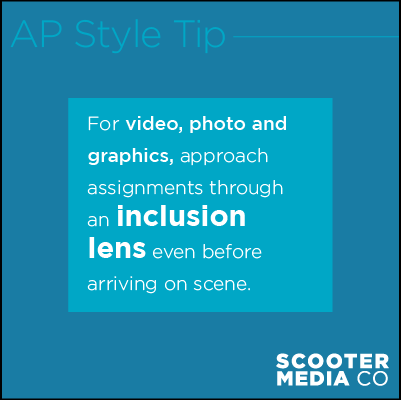We were all taught the rules of English in school, but language has a funny way of not staying the same for long. Language is constantly evolving, which is why the AP Stylebook is updated every year with new terms and trends that reflect the conversations occurring in the media and society as a whole.
Earlier this year, editors at the Associated Press revealed the 2022 AP Stylebook updates that will be included in the stylebook’s biennial printed edition, as well as online. Updates to the latest edition of the guide were largely driven by the news of the past year, according to AP Stylebook Editor Paula Froke.
Whether you’re a new PR pro or an experienced practitioner, here are the 2022 AP Stylebook updates you need to know:
#1: Inclusive Storytelling Takes Center Stage

This year, the biggest focus for the AP Stylebook editors was creating an entirely new chapter on inclusive storytelling. The chapter includes advice for both writers and editors, with a special emphasis on the language used in inclusive storytelling.
“Inclusive storytelling seeks to truly represent all people around the globe. It gives voice and visibility to those who have been missing or misrepresented in traditional narratives of both history and daily journalism,” the entry says. “It helps readers and viewers both to recognize themselves in our stories, and to better understand people who differ from them in race, age, gender, class and many other ways.”
The chapter goes on to emphasize that inclusive storytelling is essential to accuracy and fairness in writing, and it should be part of decision-making and coverage for organizations. (Need some pointers on how to make your content more inclusive? We’ve got you covered!)
#2: Two Paths Toward Inclusion
Interestingly, the AP Stylebook section on inclusive storytelling offers writers two distinct but equally important paths when writing:
- Cast a wide net: If a story requires expert insight or analysis, don’t stick to the same people that have always been the ones to share their thoughts, opinions or information. Widen the search to places you normally don’t go to. If you’re out in public looking for voices to weigh in on an issue, try to speak to a wide variety of people: different genders, ages, from different neighborhoods or communities, and more.
- Home in on individual communities or voices from that group: Often a story gets told from one perspective, but there’s an opportunity to tell deeper, enriching stories by digging a little bit deeper. The guide urges writers to examine how a larger issue can be experienced differently based on race, gender, class, age and other factors. Opportunity lies in finding those unique perspectives.
#3: Visuals Matter, Too
 We’ve all heard the phrase that “a picture is worth a thousand words” — and the 2022 AP Stylebook updates include an entire section on considerations for inclusive visuals, too.
We’ve all heard the phrase that “a picture is worth a thousand words” — and the 2022 AP Stylebook updates include an entire section on considerations for inclusive visuals, too.
“For video, photo and graphics, approach assignments through an inclusion lens even before arriving on scene. Continue to assess throughout the shoot, while producing, and when editing,” the guide advises communicators.
As with writing, the AP Stylebook stresses the importance of seeking out a diverse range of voices and faces for visual assignments, particularly for stories that don’t specifically have to do with someone’s identity.
The guide even calls for visual producers to ensure a person’s humanity is depicted with care and attention paid to lighting, angling of shots and more. Since photography has existed, it has been difficult to accurately depict people with darker skin tones. Developing film relied on one particular image of a white woman that was used by technicians to tone and color balance images for many years, leading to inaccuracies in print and broadcast media for people with darker skin tones. This new section reminds creators to ensure there is no more racial bias in their photography and videography.
#4: Putting Updates into PR Practice
 At the core of the 2022 AP Stylebook updates, editors are pushing writers and creators to strengthen their storytelling by seeking out unique, diverse perspectives that are often not considered. Simply taking the time to consider what additional voices or perspectives are missing goes a long way toward weaving a compelling narrative. To do that, expand your circle and stretch yourself. Invest the time in researching and finding new places and voices that you haven’t heard before — finding those new perspectives and angles will be more than worth the effort.
At the core of the 2022 AP Stylebook updates, editors are pushing writers and creators to strengthen their storytelling by seeking out unique, diverse perspectives that are often not considered. Simply taking the time to consider what additional voices or perspectives are missing goes a long way toward weaving a compelling narrative. To do that, expand your circle and stretch yourself. Invest the time in researching and finding new places and voices that you haven’t heard before — finding those new perspectives and angles will be more than worth the effort.
As public relations practitioners, we can apply these same principles to our work by pushing ourselves and our clients to find unique and different stories to tell about their organization, its members, and the people it serves. We can seek out diversity within the company and ensure the voices we offer up for media relations, content writing and social media are dynamic and varied. We can work toward showing diversity in the visuals that accompany press materials, pitches and social media posts.
Your work, and the end result that’s shared with the world, will be stronger for it.
Want to level up your PR writing? Discover “10 AP Style Hacks to Help Your PR Writing,” then try out “3 Tips for Improving Your PR Writing.”


